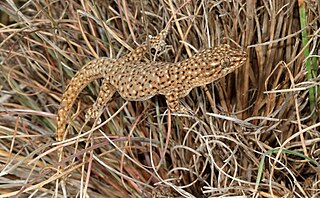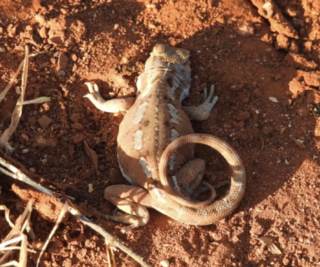
Gehyra is a genus of geckos in the family Gekkonidae. They are known as web-toed geckos or dtellas, and most species within the genus bear close resemblance to geckos from the genus Hemidactylus.

Gehyra variegata, the tree dtella, variegated dtella or varied dtella, is a species of gecko in the genus Gehyra, native to inland Australia.

Gehyra australis, the Australian house gecko, northern dtella or top-end dtella, is a species of gecko native to northern and eastern Australia. It is also widespread in Indonesia, alongside common house geckos and four-clawed geckos.

Dubious dtella, the native Australian house gecko, or dubious four-clawed gecko is a species of gecko in the genus Gehyra, native to Northeastern Australia. The lizard is found in a variety of habitats, including acacia and eucalyptus woodlands, and in human-developed habitats, such as house walls in urban areas. Its urban presence makes it known as a common house gecko in Queensland. These geckos are often confused with the Asian common house gecko, which was introduced to Australia from Indonesia, but G. dubia has distinct rounded feet and quieter calls.

The Banda Island dtella is a species of gecko in the genus Gehyra, native to the Banda Islands.

The Borroloola dtella is a species of gecko in the genus Gehyra. It is endemic to Australia. It was first described in 1983 by Max King.

The northern spiny-tailed gecko is a species of lizard in the family Diplodactylidae. The species is endemic to Australia.

Ctenophorus fionni, also known as the peninsula dragon, Arcoona rock dragon or peninsula crevice-dragon, is a species of agamid lizard occurring only in South Australia.
The Einasleigh rock dtella is a species of gecko in the genus Gehyra, native to Queensland in Australia, and first described in 2017.
Gehyra fehlmanni, also known commonly as Fehlmann's dtella or Fehlmann's four-clawed gecko, is a species of lizard in the family Gekkonidae. The species is native to Southeast Asia.

Gehyra lazelli more commonly known as the southern rock dtella or Lazell's dtella is a species of gecko in the genus Gehyra, native to Australia.
The Centralian dtella is a species of gecko endemic to Australia.
The northern spotted rock dtella is a species of gecko endemic to Australia.
The Kimberley Plateau dtella is a species of gecko endemic to Western Australia.
Gehyra punctata, also known as the spotted dtella or the spotted gecko is a species of gecko endemic to Western Australia.
The purplish dtella is a species of gecko endemic to Australia.
The crocodile-faced dtella is a species of gecko endemic to Western Australia. It was first described in 1978 by Glen Milton Storr.

Ctenophorus parviceps, commonly known as the Gnaraloo heath dragon or northwestern heath dragon is a species of agamid lizard occurring in pale coastal sands and shell grit with open heaths and beach spinifex, between the North West Cape and Carnarvon, Western Australia and on Bernier Island. The Gnaraloo Heath Dragon is a lizard that can be found along the coast of Western Australia between Exmouth Gulf and Shark Bay, and is also known as the Northwestern Heath Dragon. It is native to Australia and usually inhabits sandy coastal dunes. The species’ longevity is 3–50 years and its population density is extremely low. The Gnaraloo Heath Dragon is a member of the Agamidae family, which contains 15 genera. The lizard is under the Ctenophorus genus which has up to 33 species. This genus shows the most morphological and ecological diversity out of the three large agamid genera. 83% of the lizards in this genus lack a crest, while 17% possess crests. They are smaller than most agamids but do have relatively large heads. The Gnaraloo Heath Dragon can be differentiated from related species by a series of spines on the tail's base, a pale-grey brown broad vertebral band along its back, and hour-glass bars extending upwards to meet the pale vertebral band. It is usually 45mm in terms of length, measuring from snout to vent.

The pale-rumped ctenotus or regal striped skink is a medium-sized species of skink with an arid distribution restricted to the Australian Mainland, which belongs to the largest group of reptiles in Australia, Ctentotus.
The Shark Bay broad-blazed slider is a species of skink found in Western Australia. It was described by Storr in 1986.











